… to Lotus Connections and LotusLive are natural – Chris Sparshott is an IBMer – also check out Session 2: Social Software Potential, Practicality, Reality and Session 3 Social Software Value Metrics
Looking back at the E20SUMMIT – part 4: selected learnings
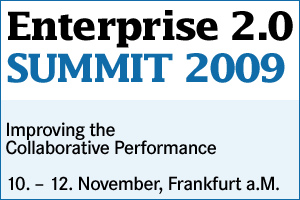 OK, now and right before LeWeb starts tomorrow it’s finally time to post the remaining parts of the summary posts on the E20SUMMIT. I mean, LeWeb will no doubt lead to an avalanche of posts and tweets, cleaning up all the drafts is essential preparation.
OK, now and right before LeWeb starts tomorrow it’s finally time to post the remaining parts of the summary posts on the E20SUMMIT. I mean, LeWeb will no doubt lead to an avalanche of posts and tweets, cleaning up all the drafts is essential preparation.
I’ve been looking back at the Wave use at the SUMMIT, at books and reports, and the social networking aspects of conferences, read people before – and I’ve already said that it’s been a good conference, with a lot of good discussions, and engaged people attending! We developed and discussed some great insights, and I want so say special thanks to all who contributed. Simon Wardley said that Enterprise 2.0 is a direction, not a state – and we’ve explored a bit of the road ahead together.
This is so necessary as Enterprise 2.0 in my view is a question of competitive advantage. And while you (and companies) don’t NEED to change, it’s a good idea to change and adapt proactively. Hence, Enterprise 2.0 thought leadership has to deal with the naysayers and the Crockologists – and this push-back is good because it forces us to think through our positions and lines of argumentation, to look at the subject from different angles and perspectives and to sharpen our understanding of both technologies and implementation approaches.
Of course there’s a place and rationale for Enterprise 2.0, and the many case studies provide ample support. Yet, we shouldn’t stop there and assume that uptake will happen naturally. It won’t – corporate resistance is real, thus finetuning Implementation and Adoption is important. Some learnings include that social it’s a bit of a tricky wording, like Andrew McAfee said during his keynote in San Francisco. Yes, words are important, and if you want to be effective it’s essential to test one’s own and the client’s understanding. Gil Yehuda argued that it’s a good idea to speak with the words your organization understands, ie. use the terminology that best resonates with the audience. And don’t use social or E20 like a mantra or mental short-cut, this will work only inside the E20 echo chamber. So we need to talk about tangible business values before we talk about technology, implementation or organizational change management. Yes, finding a non-IT team to run and foster the initiative is one good starting point. Plus, be not too picky about technologies or “solutions” – the best bet may lie in integrating different tools and let the usage emerge. We don’t want to recreate silos and “isolated effort” issues again, do we?
One of my take-aways has thus been that it’s incredibly hard to choose between a “start small – think big pilot” and a “skip the pilot” approach. Yes, it’s necessary to demonstrate quick successes – but both can work and both are potentiually risky, yet for different accounts. In the first case resistance may argue that E20 only works in this special small group of E20-geeks (are they the right ones to drive enterprise 2.0? Too many IT-people from Mars will alienate the business folks from Venus …), in the second case roll-out steps and ideas for more general adoption throughout the enterprise must be thought and budgeted ahead. In both cases the best idea seems to be really adaptable, and willing to employ various transition strategies and ideas. We’ve repeatedly learned that frontal assault is foolish – eg. fighting against email is alienating (on the contrary it should be used as a transition tool) and should be replaced by a more guerilla like adoption approach.
Yet, there are also a bit more manageable tasks and requirements. This arena comprises playing and integrating with established IT and corporate information systems. One major implementation effort and open task is enterprise search integration, being SOX compliant, and dealing with the various challenges and implications, concerns and sorrows for E2.0 deployments. The “cloud” (be it SaaS, hosted, etc.) in particular is tricky enough – see e.g. the EU Data Protection Directive and the questions of privacy it poses (yes, European perspective here, we’ve had lots of good discussions about the different challenges with E20 in Europe versus the US.)
[…] If you want to put data in the cloud that includes personal information of EU residents (and that might be something as simple as an email address or employment information), and the data will flow from the EU to almost anywhere in the world, you cannot simple throw the data in the cloud and hope for the best.
Another learning focusses on the discussions of measuring collaborative performance – the scheme of how to measure effectiveness vs. efficiency presented by Kjetil Kristensen was insightful and stressed that effectiveness of collaboration efforts is often overlooked and neglected. Yes, the value of collaboration is not collaboration itself (and sometimes you don’t people to collaborate at all, think Chinese Walls in investment banking etc.) – the values of communication and collaboration across hierachical levels and “official tasks” are various: Thinking together, not thinking alike should be the goal, while buidling up mutual understanding. Tricky, huh?
And here’s one link to the adoption and implementation issues from above: As knowledge and understanding of one companies’ vision of E20 is created in the conversation it’s essential to engage many stakeholders in the conversation, if only to connect the efforts with the actual business needs of the people. Gathering diverse perspectives and having meaningful conversations on the opportunities ahead ensures shared vision.
OK, now I’m off to Paris, it’s been kinda hard …
Looking back at the E20SUMMIT, part 3: Books and reports
Yes, right – one of my small observations at the E20SUMMIT deals with “printed paper” – and it’s importance for the advancement of Enterprise 2.0.
Gil Yehuda said at the SUMMIT that we need to choose the right words and a common vocabulary when communicating (with the C-level I think especially). It’s probably a matter of media channel too …
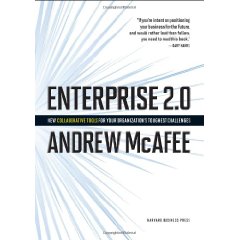 One of the books that was discussed quite a lot was Andrew McAfee’s book “Enterprise 2.0: New Collaborative Tools for your Organization’s Toughest Challenges” (Disclosure: I am going to write a detailed review soon, after all I was given the book by Andrew’s agent at HBS Publishing knowing that I’m a blogger and would probably write about it – no further arrangements have been made and I am writing my honest opinions anyway). Apparently he signed and sold hundreds of them at last weeks Enterprise 2.0 conference, the stacks look impressive for sure (see the photo by Dion Hinchcliffe who managed to be among the first in line …)
One of the books that was discussed quite a lot was Andrew McAfee’s book “Enterprise 2.0: New Collaborative Tools for your Organization’s Toughest Challenges” (Disclosure: I am going to write a detailed review soon, after all I was given the book by Andrew’s agent at HBS Publishing knowing that I’m a blogger and would probably write about it – no further arrangements have been made and I am writing my honest opinions anyway). Apparently he signed and sold hundreds of them at last weeks Enterprise 2.0 conference, the stacks look impressive for sure (see the photo by Dion Hinchcliffe who managed to be among the first in line …)
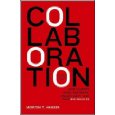 Next up with various recommendations from various people was Morton Hansen’s book “Collaboration: How Leaders Avoid the Traps, Build Common Ground, and Reap Big Results” – funny how everybody thinks this might be interesting for me 😉
Next up with various recommendations from various people was Morton Hansen’s book “Collaboration: How Leaders Avoid the Traps, Build Common Ground, and Reap Big Results” – funny how everybody thinks this might be interesting for me 😉
I should probably check it out as well, but I may have to wait until my trip to the U.S. for Lotussphere to lay my hands upon one.
…
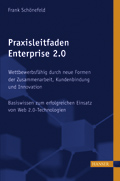 Frank Schoenefeld’s book “Praxisleitfaden Enterprise 2.0. Wettbewerbsfähig durch neue Formen der Zusammenarbeit, Kundenbindung und Innovation. Basiswissen zum erfolgreichen Einsatz von Web 2.0-Technologien” is one german language entry into this field, at the SUMMIT he said that there may be an english translation coming up … (Disclosure again: I was given the book by Frank Schoenefeld, all other rules and remarks stay the same as above …)
Frank Schoenefeld’s book “Praxisleitfaden Enterprise 2.0. Wettbewerbsfähig durch neue Formen der Zusammenarbeit, Kundenbindung und Innovation. Basiswissen zum erfolgreichen Einsatz von Web 2.0-Technologien” is one german language entry into this field, at the SUMMIT he said that there may be an english translation coming up … (Disclosure again: I was given the book by Frank Schoenefeld, all other rules and remarks stay the same as above …)
Last one in the list of “newly published” paperworks is the 20Adoption Council‘s first report on how to “roll out e20 in a large enterprise”. Sounds interesting too, and I should ask Susan or Gil about it sometime soon …
The 2.0 Adoption Council is conducting ground-breaking research on its members. As each member is screened for eligible membership in the Council, our data set is among the best in the business for early adoption of 2.0 technologies and practices.
[…] Who should buy this report?
- CEOs, CIOs, and CFOs now engaged in or planning an 2.0 strategy and execution
- Companies competing or partnering with 2.0 platform and solution vendors
- IT managers charged with providing 2.0 capabilities to their enterprise workforce
- Vendors developing community management strategies for their customers
- KM, HR, R&D managers interested in how to leverage 2.0 for the enterprise
- Venture capitalists, analysts, investment bankers, and advisors in the 2.0 consulting arena [this sounds pretty much like me, huh?].
PS. another meme I thought a bit present at the SUMMIT was “social business design”. One personal reason for this was the presentation by Jeff Dachis at the E2Conf in San Francisco I listened into the week before, another one Lee Bryant’s presentation on new forms of leadership in decentralized organizations (where he employed Dachis Group visualizations of social business design archetypes) and last reason’s Dion’s observation in both masterclass and closing note that it’s about competitive advantages (and those are the focus and goal of business model innovation and design) primarily when we deal with Enterprise 2.0.
That said I thought it cool to link to some more books on my reading list, as much from the design thinking as from the business model innovation sphere. Beginning with Design Thinking: Integrating Innovation, Customer Experience, and Brand Value by Thomas Lockwood which was recommended to me at the SUMMIT, then it’s A Fine Line: How Design Strategies Are Shaping the Future of Business by Hartmut Esslinger and Change by Design: How Design Thinking Transforms Organizations and inspires Innovation by Tim Brown of Ideo up on the slate.
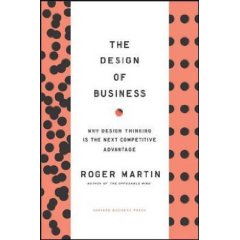 And last but not least it’s The Design of Business: Why Design Thinking is the next competitive advantage by Roger Martin where it’s time to add another disclaimer: I am going to write a detailed review soon, after all I was given the book by Roger’s agent at HBS Publishing knowing that I’m a blogger and would probably write about it – no further arrangements have been made and I am writing my honest opinions anyway (be it at my other blog Business Model Innovation and Design or here).
And last but not least it’s The Design of Business: Why Design Thinking is the next competitive advantage by Roger Martin where it’s time to add another disclaimer: I am going to write a detailed review soon, after all I was given the book by Roger’s agent at HBS Publishing knowing that I’m a blogger and would probably write about it – no further arrangements have been made and I am writing my honest opinions anyway (be it at my other blog Business Model Innovation and Design or here).
Well, after I’ve finished my little series on E20SUMMIT learnings, part 4 coming soon.
Looking back at the E20SUMMIT, part 2: Wave
 So, I am in the midst of collecting and reviewing some of my learnings from the E20SUMMIT last week – let me start with Wave (after focussing on the people of the E20SUMMIT in part 1 here), and we’ll see how many parts will follow. While this Wave at conferences evaluation may seem not really focussed on Enterprise 2.0 at first it offers some insights and learnings for the ongoing discussions of adoption and organizational readiness.
So, I am in the midst of collecting and reviewing some of my learnings from the E20SUMMIT last week – let me start with Wave (after focussing on the people of the E20SUMMIT in part 1 here), and we’ll see how many parts will follow. While this Wave at conferences evaluation may seem not really focussed on Enterprise 2.0 at first it offers some insights and learnings for the ongoing discussions of adoption and organizational readiness.
What do I mean? i think that during the SUMMIT both on-site and remote participants showed deep understanding of the usage of Wave for a conference backchannel – we’ve seen mature usage, ie. nobody misinterpreted the master- or the subwaves as a forum, as twitter substitute or as “facebook wall page”. People chose the channels that were most effective and they were professional at this.
Contrast this with the one wave that was filled during the BarCamp Hamburg (search for it with tag:bchh09), the two days after the SUMMIT – here the public wave evolved into a wild hodgepodge of close to 300 blips, together with added videos and stuff – all in all, an excellent example of what happens when geeks playfully explore a new thing 😉
 I assume that the difference is the result of provisioning of some pre-filled waves and an initial stucture – much like scaffolding a wiki this prepared and leveled the playing field, made it easier for new wavers to enter the E20SUMMIT wave space, find their way around and contribute in a meaningful way. That said, it’s probably an insight for our expectations regarding our employee’s readiness and competencies in using innovative collaboration infrastructures – even geeks on the cutting edge of the social web (like BarCampers typically are) aren’t grokking and mastering the new collaboration approaches easily. Scaffolding seems to be an essential element of enabling them (and their much less geeky colleagues). As such it’s a part of the “implementation effort” (in quoting signs because as we’ve learned at the SUMMIT implementation means different things to different people), I collect and systematize under the notions of “kennen-können-wollen-sollen”, ie. “know about it – master it – want it – be obliged (and ordered to)”. Scaffolding supports all four areas, and consequentially enabled the sustainable growth of the E20SUMMIT waves …
I assume that the difference is the result of provisioning of some pre-filled waves and an initial stucture – much like scaffolding a wiki this prepared and leveled the playing field, made it easier for new wavers to enter the E20SUMMIT wave space, find their way around and contribute in a meaningful way. That said, it’s probably an insight for our expectations regarding our employee’s readiness and competencies in using innovative collaboration infrastructures – even geeks on the cutting edge of the social web (like BarCampers typically are) aren’t grokking and mastering the new collaboration approaches easily. Scaffolding seems to be an essential element of enabling them (and their much less geeky colleagues). As such it’s a part of the “implementation effort” (in quoting signs because as we’ve learned at the SUMMIT implementation means different things to different people), I collect and systematize under the notions of “kennen-können-wollen-sollen”, ie. “know about it – master it – want it – be obliged (and ordered to)”. Scaffolding supports all four areas, and consequentially enabled the sustainable growth of the E20SUMMIT waves …
Choose the right (social web) tools
Andrea is giving us still more videos he recorded at Somesso this week – see his site for all of them. I decided to embed at least one of those, it’s Lee Bryant from Headshift, now part of Dachis Group and also one of the speakers at the upcoming E20SUMMIT, half and hour about “which tools banks, insurances and other companies in the financial industry [should] investigate and which are the costs and degrees of difficulty in adoption”:
Yes, this adoption meme is keeping me up at night – and there’s some posts brewing right now.
Oliver Marks and Andrew McAfee at the Enterprise 2.0 conference
During the last two days I have spent the better part of my nights listening in to and participating in the discussion at the Enterprise 2.0 conference in San Francisco. This wasn’t only Twitter, quite some documenting took place in Google Wave too (that’s global collaboration, me and Dan editing the same blip while being literally thousands of miles away from each other, for #nirvana we only need to sort out the time zone problems). Some notes and thoughts are still forming and may end up in a frogpond- or enterprise2open-blog post soon …
Until then this video is a good thing to watch, Oliver Marks (who happens also to be one of the headliners at next week’s E20SUMMIT) talking with Andrew McAfee (new book here: Enterprise 2.0: New Collaborative Tools for Your Organization’s Toughest Challenges) about the conference, it’s target audience and about the current state of the discussion around Enterprise 2.0.
We discuss the strengths of the event – the evangelists and middle ranking employee success stories – but also note the need for impressing on senior ‘C’ suite decision makers in organizations the business value of these modern ideas and associated technologies.
There are at least two interesting things to notice in there, one: the discussion is evolving quickly and the experts have since long stopped to mull over questions of definition, why even of questioning RoI. The real topics are now the necessary steps we all should take to get the C-Suite from “being interested” to becoming active sponsors – and how to explain the tangible benefits of collaborative performance. Systems are ready and able, experienced consultants ditto and may work for the satisfaction of being the change you want to see money. Gentlemen, please let your projects start.
The other thing is the obervation I absolutely second that middle-level people aren’t the roadblock, in fact they are the necessary ingredient of Enterprise 2.0 success and make out most of the participants both at the Enterprise 2.0 conference and the upcoming E20SUMMIT. This isn’t by chance or “because they were told to go” but because they feel the need and the willingness to change with and by Enterprise 2.0.
Futureprise 2.0 – Erfolgsfaktoren der Beratung
Futureprise? Ein schöner Neologismus wie ich finde, entstanden als jemand den Sessionplan vom BarCamp-München Samstag vom handschriftlich editierten Open Grid abgetippt hat und so u.a. aus einem großen E ein F wurde … Aber man kann dann durchaus auf die Zusammenhänge zwischen Futureprise 2.0 und Enterprise 2.0 eingehen – da ist aus meiner Sicht Potenzial enthalten?
In jedem Fall waren die Trends und Aussichten von Enterprise 2.0 Thema meiner Session beim BarCamp München, mit speziellem Fokus auf die Beratung in diesem Kontext. Im Grunde entstand so eine Gesprächsrunde in der wir uns locker und informell über die Erfolsgfaktoren der Beratung zum Enterprise 2.0 ausgetauscht haben. Neben Björn und mir haben u.a. Sebastian, Ludwig und Karsten mitdiskutiert. Interessant, wir haben zwar nicht direkt Dions Ideen zum Pragmatic Enterprise 2.0 service offering diskutiert (“proactive risk monitoring and governance”) aber letztlich war doch das Fazit dass es eines pragmatischeren Beratungsansatzes bedarf. Björn hat Dion dazu interviewt, auf dem enterprise2open Blog stellt er uns die Frage ob das das fehlende Puzzlestück sein kann, um Enterprise 2.0-Projekte erfolgreich zu machen?
Im Gespräch mit Susan Scrupski haben wir das bereits am KnowledgeCamp in Karlsruhe diskutiert – speziell die Fragestellung wie man “organizational traction” schaffen kann, u.a. anhand der Frage wie man als Berater die richtigen Promotoren im Unternehmen finden kann, Promotoren die sowohl top-down Unterstützung geben können als auch mit den bottom-up Entwicklungen zurechtkommen.
Ich persönlich bin noch ein bisschen skeptisch was Dions Fokussierung angeht – andererseits vertraue ich ihm fachlich unbedingt, und auch die Mannschaft mit Michael Krigsman und Ross Mayfield passt. Aber wenn ich vorsichtig (und etwas pessimistisch) argumentiere könnte es ja auch sein dass die Frage nach “governance und risk management” nur eine nette Art ist “Nein” zu sagen. Aber wie gesagt, ich bin nur ein bisschen skeptisch, wenn diese Aspekte Schwierigkeiten bereiten tun wir gut daran sie anzugehen. Und wenn das Top-Management diese Aspekte behandelt haben möchte bevor es ein Commitment gibt, kein Problem.
Letztlich steckt dahinter auch bei Dion ein umfassendes Stakeholder- und Kontext-Management, welches davon ausgeht dass spezielle Einflußgruppen spezielle Argumente und Informationen benötigen. Ohnehin kommt es ja weniger darauf an wie man etwas benennt, sondern darauf was man macht (viele Enterprise 2.0 Projekte laufen in Deutschland denn auch unter anderem Namen).
 Dem Thema Enterprise 2.0 tut etwas Realismus gut, insofern freue ich mich auch darauf dass wir in drei Wochen mit dem E20SUMMIT eine Gelegenheit bekommen, das Thema (mit Dion) innerhalb der E20-Beraterszene aber auch mit Praktikern (und interessierten “Noch-nicht-Anwendern” zu führen).
Dem Thema Enterprise 2.0 tut etwas Realismus gut, insofern freue ich mich auch darauf dass wir in drei Wochen mit dem E20SUMMIT eine Gelegenheit bekommen, das Thema (mit Dion) innerhalb der E20-Beraterszene aber auch mit Praktikern (und interessierten “Noch-nicht-Anwendern” zu führen).
P.S. Wer von meinen Lesern an dieser Veranstaltung teilnehmen möchte, aber vom Preis abgeschreckt ist, kann sich bis Mitte nächster Woche noch bei mir melden um einen Ermäßigungscode zu bekommen.